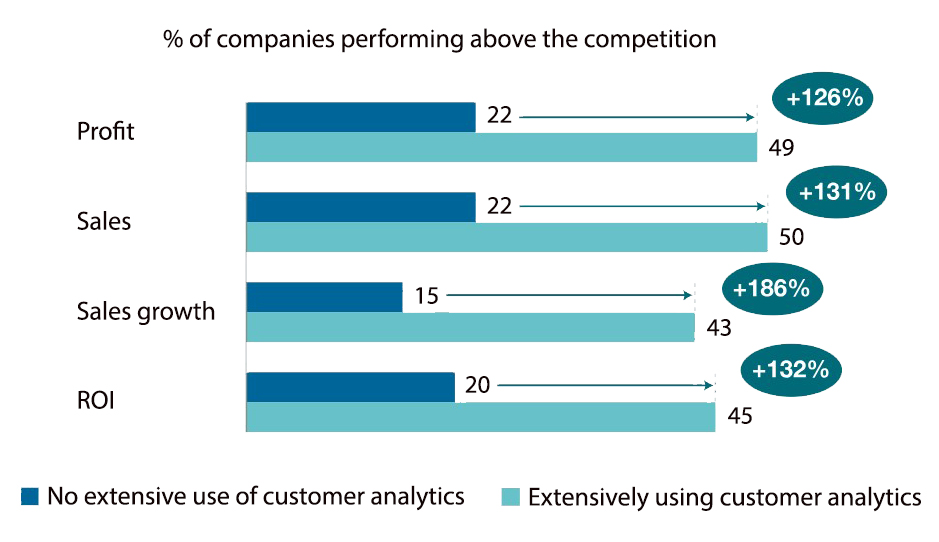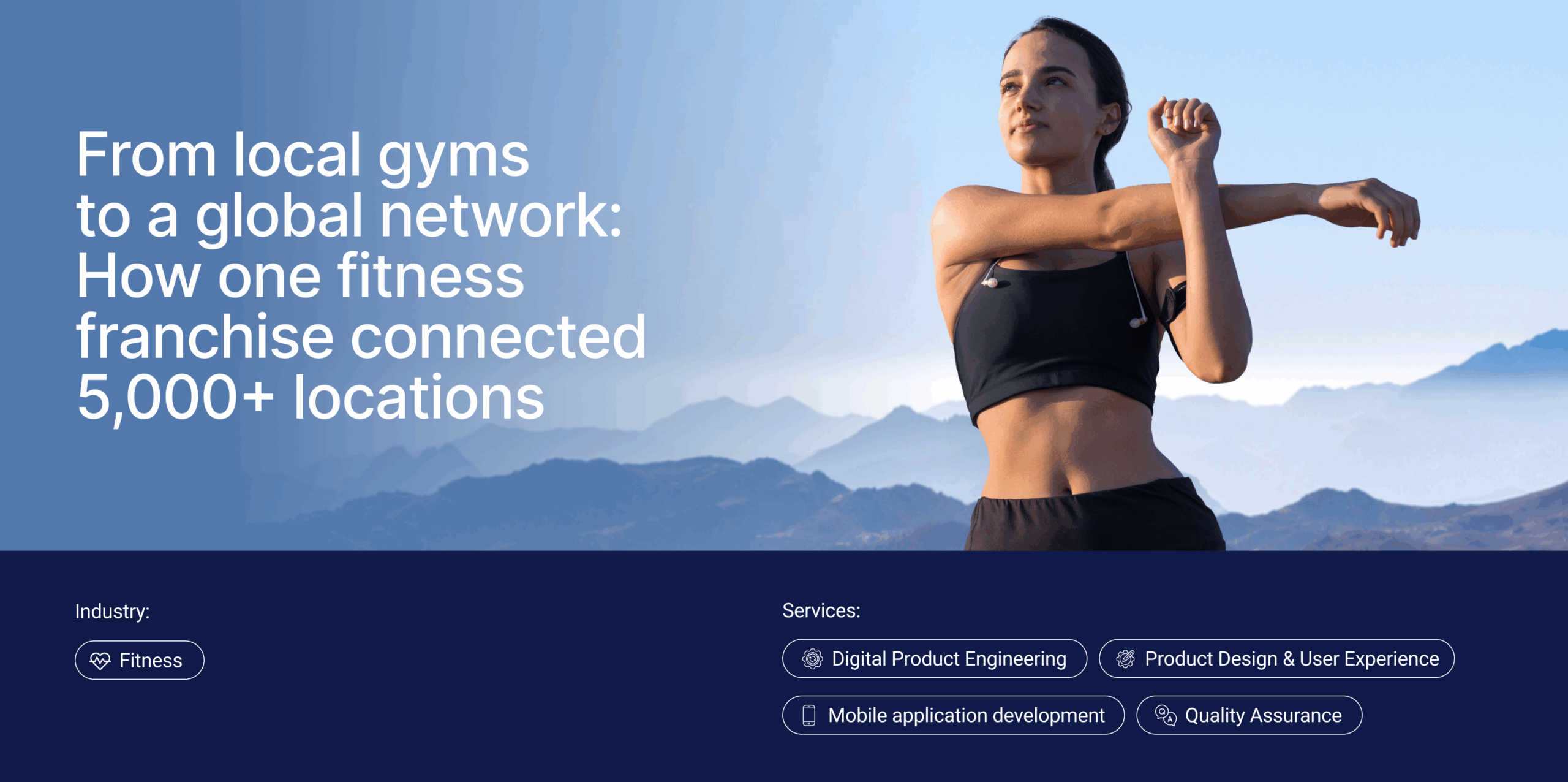
Data analytics has become a cornerstone of modern business strategy, driving innovation and competitive advantage across industries. From eCommerce giants fine-tuning customer experiences to healthcare providers revolutionizing patient care, companies use big data analytics to make informed decisions.
The technology is experiencing exponential growth as advanced analytics expands cloud architectures and offers innovative operational design patterns. The widespread adoption of smart devices, the ubiquity of social media, and the deployment of countless sensors drive unprecedented data integration in 2024.
Read on to find out about the recent trends in data analytics across 7 key industries: healthcare, accounting, banking and finance, insurance, human resources, manufacturing, and retail.
Current Trends in Data Analytics
In a modern data-driven business landscape, if you do not embrace the opportunities of data analytics platforms and tools, you are bound to fall short. If you want to stay competitive, data-driven initiatives should be at the top of your priority list.
These are not just words. Just look at these data and analytics trends:
- The global big data analytics market is worth over $300 billion.
- 3 in 5 organizations are using data analytics to drive business innovation.
- Over 90% of organizations achieved measurable value from data and analytics investments in 2023.
- Companies that employ data-driven decision-making, increase their operation’s productivity rate to 63%.
Microstrategy gives a good breakdown of the benefits businesses extract from enhanced analytics:

Beyond that, Mckinsey found that integrating customer data analytics in business funnels improves growth and enlarges profits by at least 50%:

At the same time, Kearney reports that transitioning from basic to advanced business analytics gives a boost of 81% in profitability.
Data Analytics Technology Trends 2024
Data analytics in 2024 is driven by AI, machine learning, NLP, data mesh, edge computing, and cloud technologies. These innovations enable faster processing, improved insights, and wider data accessibility. Let’s take a closer look at these trends.
Artificial Intelligence and Machine Learning
Businesses can now automate an even wider range of data processing tasks, from anomaly detection to predictive maintenance. Thanks to artificial intelligence technology, AI and ML-powered forecasting has become increasingly sophisticated, allowing organizations to anticipate market trends and user behavior with remarkable accuracy.
Natural Language Processing
From sentiment analysis of customer feedback to content summarization and classification, NLP plays a pivotal role in data analysis. The technology widens the range of data sources, informing strategic decisions with a richer, more nuanced understanding of market trends and customer needs.
Data Mesh
By decentralizing data ownership and governance, data mesh enables cross-functional teams to easily access, share, and derive insights from their data assets. This has led to improved data-driven collaboration and the extraction of greater value from corporate data.
Edge Computing
By processing data closer to its source, edge solutions minimize latency and bandwidth usage, making them ideal for real-time analytics in IoT, industrial, and other time-sensitive environments. This has enabled organizations to detect anomalies, predict maintenance needs, and make rapid, informed decisions based on sensor data.
Data-as-a-Service
DaaS platforms allow businesses to outsource data storage, processing, and predictive modeling, empowering them to leverage enterprise-grade tools and expertise without the need for significant infrastructure investments.This trend has opened the door for smaller companies to compete on a more level playing field.
Data Democratization
Leading enterprises have prioritized data democratization to foster a more collaborative, data-literate culture. By making data and analytics tools available to a wider range of decision-makers, organizations are breaking down silos, improving cross-functional alignment, and accelerating time-to-insight.
Big Data Integration
Organizations increasingly invest in advanced analytics solutions, powered by Big Data. From predictive maintenance in manufacturing to hyper-personalized marketing in retail, data-driven decision-making has become essential for maintaining a competitive edge in today’s fast-paced, data-rich business environment.
Cloud Computing
Cloud-based platforms offer improved accessibility, scalability, and cost-efficiency, empowering organizations to rapidly scale their data processing and storage capabilities to meet evolving business demands. Companies now focus on extracting insights from their data using cloud-native applications rather than managing complex on-premises infrastructure.
Ready to Get More from Your Data with Advanced Analytics?
Harness the power of AI, ML, and more cutting-edge tech with tailored data solutions that give you a competitive advantage.

1. Data Analytics in the Healthcare Industry
Recent data analytics trends show data-driven solutions significantly impacting the business side of healthcare.
In 2024, more than 70% of healthcare institutions use cloud computing to facilitate real-time data sharing and collaboration.
Cloud-native data analytics platforms help them predict trends, personalize treatments, enhance patient outcomes, improve operational efficiency, and streamline operations.
AI-Powered Diagnostics
AI algorithms are enhancing diagnostic accuracy across various medical fields. Machine learning models can now analyze medical imaging with superhuman precision, detecting subtle abnormalities in X-rays, MRIs, and CT scans. This technology is accelerating diagnosis, reducing human error, and enabling earlier intervention for conditions like cancer and heart disease.
Predictive Analytics
Healthcare providers are increasingly using predictive models to anticipate patient needs and outcomes. These tools analyze historical data to forecast disease progression, identify high-risk patients, and optimize resource allocation. Predictive analytics is proving particularly valuable in managing chronic diseases and preventing hospital readmissions, leading to improved patient care and reduced healthcare costs.
Value-Based Care and Population Health Management
Data analytics is driving the shift towards value-based care models, focusing on patient outcomes rather than service volume. By analyzing population health data, healthcare organizations can identify trends, target interventions, and allocate resources more effectively. This approach improves overall community health while optimizing healthcare spending and quality of care.
Personalized Medicine and Precision Healthcare
Analytics is enabling tailored treatment plans based on an individual’s genetic makeup, lifestyle, and environmental factors. By analyzing vast datasets of genetic information and treatment outcomes, healthcare providers can predict drug efficacy and potential side effects for specific patients, leading to more effective treatments and improved patient outcomes.
Internet of Medical Things and Real-Time Data Processing
The proliferation of connected medical devices is generating unprecedented amounts of real-time patient data. Advanced analytics platforms can process this data stream, providing immediate insights to healthcare professionals. This enables continuous patient monitoring, early detection of health issues, and rapid response to critical situations, enhancing both in-hospital care and remote patient management.
Data Architecture and Governance
Healthcare organizations are prioritizing robust data architecture and governance to manage the growing volume of health data securely and efficiently. This includes implementing interoperable systems, ensuring data quality, and maintaining patient privacy. Strong data governance enables seamless data sharing across healthcare networks, facilitating collaborative research and improving continuity of care.

2. Data Analytics Trends in Accounting
According to Xerox’s Accounting & Bookkeeping ‘State of the Industry’ Report for 2023, 66% of businesses in the accounting service industry reported improved staff retention, increased revenue, and higher profits—all thanks to cloud accounting software.
Data analytics enhances the ways accountants analyze data, predict trends, and source strategic insights. Accounting firms and experts use this technology to elevate their operational efficiency and make more informed financial decisions.
AI Automation in Accounting
AI-powered automation is streamlining routine accounting tasks, from data entry to reconciliation. Machine learning algorithms can process vast amounts of financial data, identify patterns, and flag anomalies with unprecedented speed and accuracy. This not only reduces human error but also frees up accountants to focus on higher-value activities like financial strategy and advisory services.
Cloud Accounting
Cloud-based accounting solutions enable real-time collaboration, remote access, and seamless integration with other business systems. This shift to the cloud enhances data security, scalability, and accessibility, allowing accountants to work more efficiently and provide timely insights. Cloud platforms also facilitate easier compliance with evolving regulations and standards.
Advanced Data Analytics Tools
Sophisticated analytics tools are empowering accountants to extract meaningful insights from complex financial datasets. These tools enable predictive modeling, scenario analysis, and data visualization, enhancing financial forecasting and risk management. By leveraging advanced analytics, accountants can provide more strategic guidance to businesses, driving informed decision-making and value creation.
Business Intelligence in Accounting
Business intelligence tools are transforming how financial data is analyzed and presented. Interactive dashboards and visual analytics enable accountants to communicate complex financial information more effectively to stakeholders. This trend is enhancing financial reporting, performance monitoring, and strategic planning, allowing businesses to respond more quickly to market changes.
3. The Future of Data Analytics in Banking and Finance
McKinsey reports that banks and finance institutions that implement advanced analytics workbenches in 2024 witnessed their corporate and commercial revenues rise by more than 20% over three years.
Analytics allow finance experts to tailor products to individual needs, reduce fraud incidents by analyzing transaction patterns, and improve loan approval processes through predictive modeling. And that is just the tip of the iceberg.
Investment in Data Initiatives
Financial institutions are significantly increasing their investments in data analytics initiatives. This trend reflects the growing recognition of data’s strategic value in driving business growth and operational excellence. Banks are allocating resources to build robust data infrastructures, develop advanced analytics capabilities, and cultivate data-driven cultures across their organizations.
Market Growth
The big data analytics market in banking is experiencing rapid expansion, driven by the increasing adoption of digital technologies and the growing volume of financial data. This growth is fueled by the demand for real-time analytics, personalized financial services, and improved risk management capabilities. As the market evolves, we’re seeing a rise in specialized analytics solutions tailored for specific banking functions.
Advanced Data Analytics in Banking
Banks are leveraging advanced analytics techniques to gain a competitive edge in corporate and commercial banking. These tools enable more accurate credit risk assessment, personalized product recommendations, and optimized pricing strategies. By harnessing the power of machine learning and AI, banks can provide tailored financial solutions and improve customer retention in increasingly competitive markets.
Big Data Analytics and Risk Management
Data analytics is transforming risk management in banking, enabling more sophisticated approaches to identifying, assessing, and mitigating risks. Advanced analytics models can process vast amounts of structured and unstructured data to detect fraud patterns, assess creditworthiness, and predict market volatility. This data-driven approach enhances regulatory compliance and strengthens overall financial stability.
Technology Integration
Banks are focusing on integrating data analytics capabilities across their entire technology stack. This involves modernizing legacy systems, adopting cloud-based platforms, and implementing advanced data management tools. By creating a unified data ecosystem, banks can break down silos, improve data quality, and enable more agile and responsive decision-making processes throughout the organization.

4. Data Analytics Trends in Insurance
According to Deloitte’s insurance industry outlook, firms that follow current trends in data analytics can improve agent productivity by up to a whopping 130%.
By taking advantage of real-time data and insights, insurers can more accurately assess risks, effectively set premiums, personalize underwriting services, and streamline claim management.
Integration of Data Streams
Insurers are increasingly integrating diverse data sources, from telematics to social media, to gain a holistic view of their customers and operations. This unified data environment enables more accurate risk analysis, targeted product recommendations, and proactive customer engagement, driving business growth and customer loyalty.
Hyper-Automation
The insurance sector is embracing hyper-automation, leveraging AI and robotic process automation to streamline a wide range of tasks, from underwriting to claims management. By automating repetitive, data-intensive activities, insurers can reduce errors, accelerate processing times, and free up employees to focus on higher-value, customer-centric initiatives.
Telematics and Real-Time Data
The use of telematics and other IoT devices is transforming how insurers collect and analyze customer data. By monitoring driver behavior, home sensor data, and other real-time information, insurers can offer personalized pricing, enhance risk assessment, and provide proactive support to policyholders, improving overall customer experience and retention.
Ethical and Trustworthy AI
As insurers increasingly rely on AI-powered decision-making, there is a growing emphasis on ensuring these systems are transparent, unbiased, and accountable. Insurers are implementing robust governance frameworks and explainable AI models to build trust, comply with regulations, and make ethical use of customer data and predictive insights.
5. Human Resources Trends
When Google recently employed data analytics to supercharge its HR process, the tech giant noticed that successful candidates could be predicted with 86% confidence from just four interviews. Ultimately, it allowed them to streamline tasks and minimize the time required to screen job applicants.
Advanced analytics workstations allow HR managers to make data-driven decisions about talent acquisition and retention, workforce planning, and employee engagement.
Machine Learning in HR Data Analytics
Machine learning algorithms are enabling HR teams to extract meaningful insights from employee data. These advanced analytical techniques can identify patterns, predict employee attrition, and personalize career development interventions, helping organizations build high-performing, engaged workforces.
Predictive Analytics
HR professionals are increasingly turning to predictive analytics to forecast staffing needs, assess candidate fit, and identify high-potential employees. By analyzing historical data and external factors, these models can inform strategic workforce planning, talent acquisition, and succession management.
Diversity, Equity, and Inclusion (DEI) Analytics
Data-driven DEI initiatives are helping organizations foster more inclusive and equitable work environments. Analytics tools can track representation, measure the impact of DEI programs, and uncover potential bias in HR decision-making, empowering leaders to take evidence-based actions to improve diversity and inclusion.
Employee Sentiment Analysis
Text analytics and natural language processing are enabling HR teams to gain deeper insights into employee sentiment. By analyzing feedback from surveys, social media, and other channels, organizations can identify drivers of engagement, address pain points, and enhance the overall employee experience.
6. Data Analytics Trends in Manufacturing
Data analytics and cloud computing are foundational technologies on the path of creating an industrial metaverse. It allows businesses to take advantage of such tech as digital twins, 3D modeling, and 3D scanning and generate data-rich 3D immersive models of manufacturing processes.
According to Deloitte, manufacturers who started implementing some of the initiatives that go into creating an industrial metaverse have witnessed a 12% boost in such metrics as sales efficiency, quality, throughput, and labor productivity.
Predictive Maintenance
Advanced analytics models are transforming maintenance strategies, allowing manufacturers to predict equipment failures and schedule proactive interventions. By analyzing sensor data and historical maintenance records, these predictive models reduce unplanned downtime, minimize repair costs, and extend the lifespan of critical assets.
Digital Twins
The use of digital twins—virtual representations of physical assets—is on the rise in manufacturing. By integrating real-time data from IoT sensors, these digital models enable scenario testing, performance optimization, and predictive maintenance, leading to improved product quality, operational efficiency, and innovation.
IoT Integration
The growing prevalence of IoT devices in manufacturing is generating vast amounts of data that can be leveraged through advanced analytics. By connecting machinery, supply chains, and logistics, manufacturers can gain end-to-end visibility, identify optimization opportunities, and respond more quickly to market demands.
Edge Computing
Edge computing is empowering manufacturers to process data closer to the source, reducing latency and improving real-time decision-making. This approach enables faster anomaly detection, predictive maintenance, and quality control, leading to enhanced productivity and reduced operational costs.
Supply Chain Analytics
Data-driven insights are transforming supply chain management, enabling manufacturers to forecast demand, optimize inventory levels, and mitigate disruptions. Advanced analytics tools can identify patterns, predict lead times, and simulate scenarios, helping organizations build more resilient and responsive supply networks.

7. Retail Data Analytics Trends
Research published by Statista shows that retailers who have adopted AI and machine learning-powered analytics have 5-6% higher sales and profit growth rates than those who neglect these solutions.
Data analytics is also key to creating an omnichannel strategy that is so coveted by retailers today, supporting them in a battle against modern digital eCommerce competitors.
Retailers collect and analyze data from multiple channels in real-time and gather insights to improve their personalized marketing and inventory management efforts.
Demand Forecasting
Advanced analytics models are enabling retailers to forecast demand with unprecedented accuracy. By analyzing historical sales data, customer behavior, and external factors, these predictive tools help retailers optimize inventory levels, minimize stockouts, and enhance supply chain efficiency.
Market Predictions
Retail data analytics is providing valuable insights into emerging market trends and customer preferences. Leveraging big data and machine learning, retailers can identify new growth opportunities, tailor product assortments, and develop targeted marketing strategies to stay ahead of the competition.
Customer Segmentation
Retailers are using sophisticated data analytics to segment their customer base and deliver highly personalized experiences. By analyzing demographic, behavioral, and psychographic data, organizations can create targeted campaigns, optimize pricing, and enhance customer loyalty through relevant, value-added offerings.
Customer Sentiment Analysis
Text analytics and natural language processing are empowering retailers to gain real-time insights into customer sentiment across various channels, from social media to product reviews. This enables them to quickly identify and address pain points, improve customer satisfaction, and foster stronger brand affinity.
Dynamic Pricing
Leveraging data analytics, retailers are implementing dynamic pricing strategies to optimize revenue and respond to market fluctuations. By analyzing factors like competitor pricing, inventory levels, and customer demand, these models enable real-time adjustments to pricing, improving profitability and competitiveness.
Real-World Data Analytics Examples and Success Stories
There’s no more doubt data analytics is a cornerstone to enhancing operational efficiency and strategic decision-making. Let’s look closer into some real success stories of businesses that have harnessed the power of data to achieve remarkable outcomes.
Massachusetts General Hospital
Massachusetts General Hospital leveraged predictive analytics to identify high-risk patients and implement proactive intervention programs. This data-driven approach reduced hospital readmissions by 22% and lowered overall healthcare costs while improving patient outcomes and quality of life.
PwC
In 2024, PricewaterhouseCoopers (PwC) implemented advanced data visualization tools, enabling their clients to gain real-time insights into financial performance. This transformation enhanced strategic decision-making, increased profitability, and strengthened client relationships through more transparent, data-driven advisory services.
JPMorgan Chase
JPMorgan Chase utilized big data analytics to enhance its credit risk assessment capabilities. By analyzing alternative data sources, the bank improved loan underwriting accuracy and reduced default rates, bolstering its financial stability and competitiveness.
Success Story From Coherent Solutions
Planet Fitness, a global fitness giant, partnered with Coherent Solutions to revolutionize its customer intelligence. Leveraging our rich analytics arsenal, we crafted a cutting-edge data solution, unlocking a 360-degree view of fitness club members.
This process involved mining SQL databases, exploratory analysis, and transforming this data into detailed customer profiles. The solution featured personalized insights about customers spanning fitness goals, biometrics, and training preferences.
Our advanced data analytics allowed Planet Fitness to provide more personalized services, improve satisfaction, and foster long-term loyalty by deeply understanding their clients’ needs.
Embrace Advanced Data Analytics with Coherent Solutions
Coherent Solutions is your trusted tech partner using advanced tools to uncover historical insights, patterns, and relationships that inform strategic decision-making. Join us as we refine raw data into actionable intelligence that brings you within arm’s reach of your goals and objectives.
Why Choose Coherent Solutions
- Serving Fortune 500 companies globally across 10 locations.
- Long-standing partnerships with Microsoft and AWS.
- Data protection and quality are among our top priorities.
- Streamlined processes for faster time-to-market.
- Comprehensive support from leading experts in business intelligence.
Frequently Asked Questions
What are the common pain points that lead organizations to invest in advanced data analytics?
Many businesses struggle with siloed data, lack of analytical skills, and difficulties deriving meaningful value from their information assets. Key pain points include the inability to make timely, informed decisions, missed opportunities for growth and efficiency, frustration from business users who lack self-service analytics, and concerns about data security and compliance as analytics initiatives expand.
How can data analytics help organizations overcome common business challenges?
Successful data analytics initiatives can enable organizations to optimize operations, enhance the customer experience, identify new revenue opportunities, and mitigate risks. Leading companies leverage data-driven capabilities to outpace competitors, improve decision-making, and achieve tangible business outcomes.
What specialized skills and roles are essential for building an effective data analytics team?
Businesses require a multidisciplinary team with diverse skill sets, including data engineers to build scalable infrastructure, data scientists skilled in advanced analytics, business analysts who can translate insights into action, and visualization experts adept at designing intuitive dashboards. Domain experts and data governance/ethics specialists are also crucial for aligning analytics with business priorities and regulatory requirements.
What are the common roadblocks organizations face when implementing advanced data analytics?
Common challenges include poor data quality and governance, difficulty recruiting specialized talent, organizational silos that hinder collaboration, complexity in selecting and integrating analytics technologies, resistance to change from business users, and concerns about ethical data use and compliance. Overcoming these barriers requires a comprehensive strategy aligned with the organization’s broader digital transformation goals.
How can organizations ensure a strong return on investment (ROI) from their data analytics initiatives?
To maximize ROI, business executives should clearly define high-impact use cases, foster a data-driven culture, invest in scalable data infrastructure and intuitive analytics platforms, establish robust data governance policies, promote cross-functional collaboration, and continuously measure and iterate on their initiatives. Following these best practices can help organizations realize tangible benefits such as increased revenue, reduced costs, and improved operational efficiency.
What emerging technologies and innovations are poised to shape the future of data analytics?
The data analytics landscape is evolving rapidly, with technologies like augmented analytics, edge computing, explainable AI, DataOps, cognitive computing, and multimodal analytics expected to transform the field. As these innovations mature, they will empower organizations to extract even greater value from their data and stay ahead of the competition.





